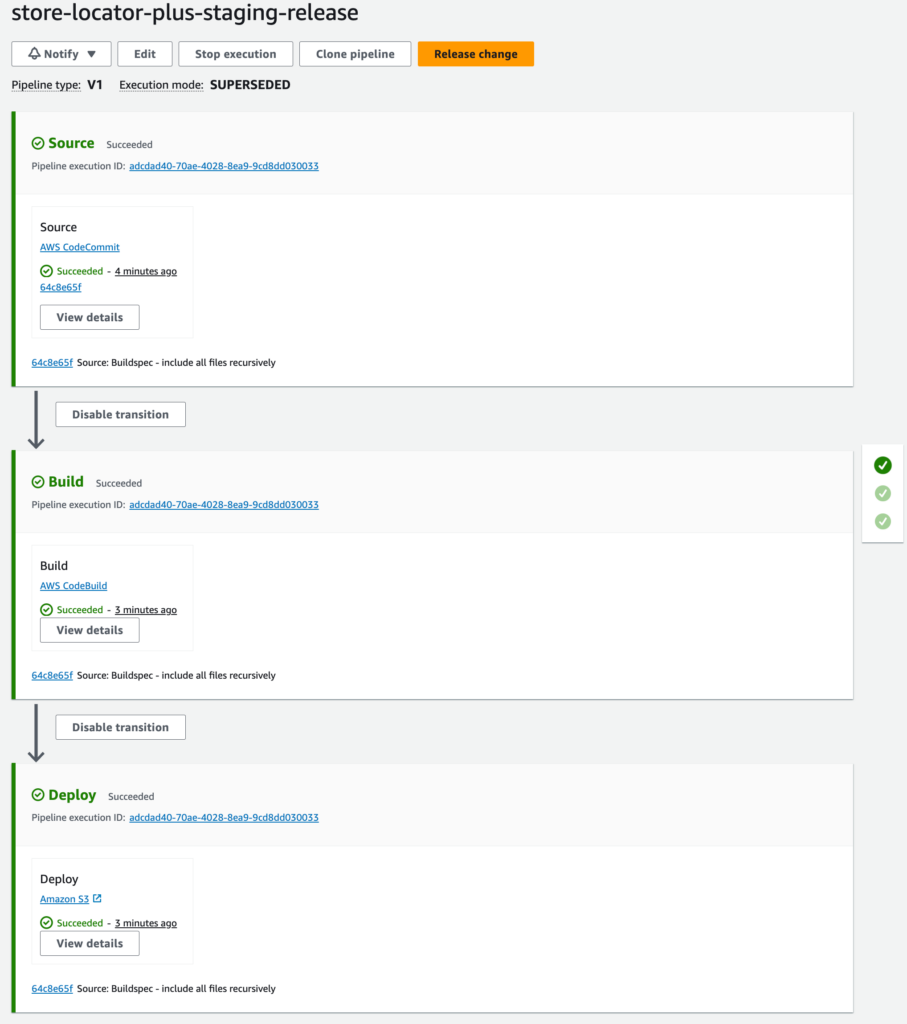This process is for updating the staging Store Locator Plus® SaaS server running on an ECS cluster after performing code updates.
These processes require a locally installed copy of the MySLP AWS ECS Kit repository which can be found at ssh://git-codecommit.us-east-1.amazonaws.com/v1/repos/myslp_aws_ecs_kit.
Edit your code or deployment kit files first. This can include WordPress plugins or themes, the Docker composer or image builder commands, helper scripts, or various configuration files used to manage and deploy the Store Locator Plus® SaaS container images.
Once your updates are ready, make sure the WordPress stack is up-to-date by updating the submodule links, then commit all of your updates to the MySLP AWS ECS Kit repository on the proper branch. There are AWS CodePipeline services running that will monitor the repository for changes, build any images as needed with ECR and deploy them via the Elastic Container Service if possible. Details on the processes are noted below.
Update The Submodules
From the MySLP AWS ECS Kit git project root:
./tools/create_mustuseplugins_stubs.shCommit The Code Updates To The Repo
Commit any changes to the MySLP AWS ECS Kit repository.
When you push the changes from your local develop, staging, or production branch an AWS listener service will detect the code changes and run Code Pipeline tied to services such as CodeBuild and ECS to deploy the final Store Locator Plus® SaaS container in the AWS cloud.
Commits to local branches will not trigger a change in the AWS deployments.
Commits to any branch not specifically named develop, staging, or production will not trigger changes in the AWS cloud deployments.
CodePipeline Notes
The CodePipeline that is configured to deploy the staging containers is named myslp-webserver-staging-pipeline.
Stage: Source
The pipeline monitors the staging branch on the AWS CodeCommit repo for the MySLP AWS ECS Kit project at ssh://git-codecommit.us-east-1.amazonaws.com/v1/repos/myslp_aws_ecs_kit
Stage: Build
The source will be read from the URL above and a series of commands will be executed in the cloud to create an container image. This image is stored in the AWS Elastic Container Registry as a private image.
The Store Locator Plus® SaaS (internal name: MySLP) container images are stored in the 744590032041.dkr.ecr.us-east-1.amazonaws.com/myslp2024-aarch64 docker image repository.
Staging branches will tag the latest build with the :staging tag.
Stage: Deploy
The deploy stage will execute if the build stage completes successfully. This stage will attempt to take the latest myslp2024-aarch64:staging ECR image and launch an active container in the AWS Elastic Container Service.
The deploy stage will attempt to launch a running container in the myslp-staging-cluster on the myslp-staging-service service within that cluster.

Manual Container Image Update
Build The Container Image and Store On AWS ECR
aws sso login --profile lance.cleveland
aws ecr get-login-password --region us-east-1 --profile lance.cleveland | docker login --username AWS --password-stdin 744590032041.dkr.ecr.us-east-1.amazonaws.com/myslp2024-aarch64
cd ./Docker/Images
docker build --platform=linux/arm64 -t 744590032041.dkr.ecr.us-east-1.amazonaws.com/myslp2024-aarch64:staging .docker push 744590032041.dkr.ecr.us-east-1.amazonaws.com/myslp2024-aarch64:staging






